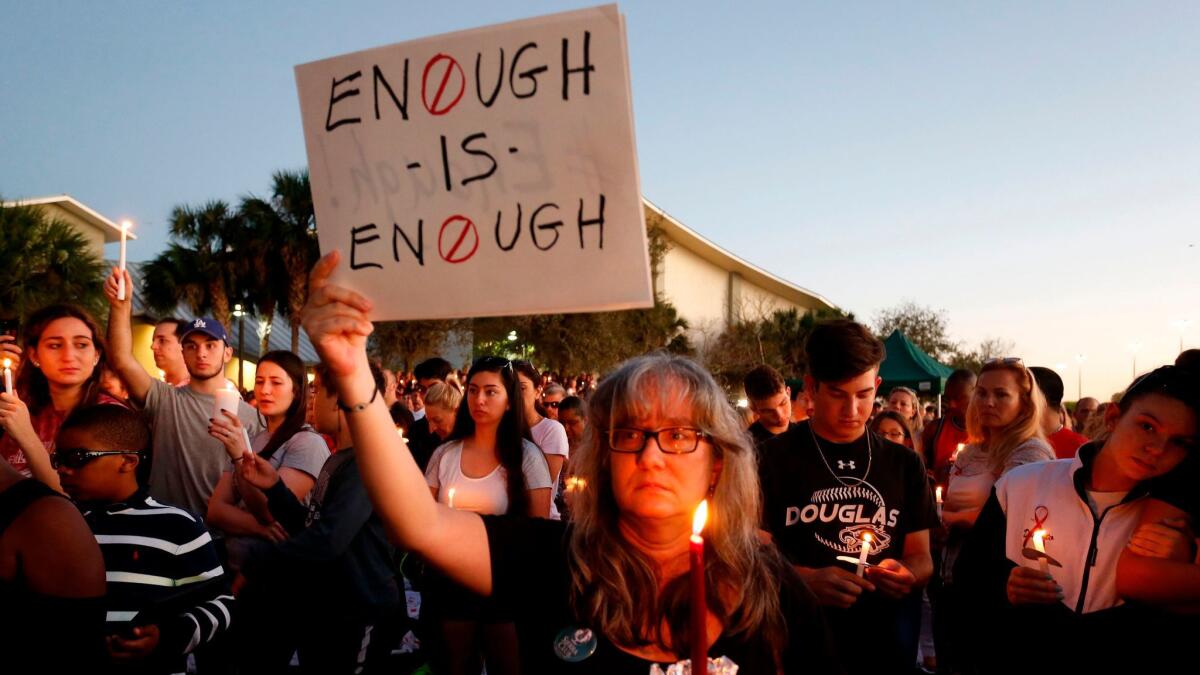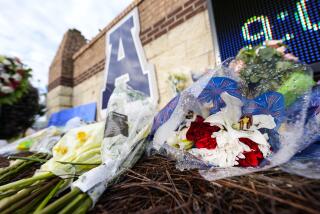Before a school shooting, something usually happens — the shooter tells someone

- Share via
In the days following the deadly high school shooting in Florida, as Nikolas Cruz’s life as a troubled teen began to come into focus, a disturbing truth emerged: People had known where he might be headed.
“Everyone called him ‘the school shooter,’ ” Rachelle Jean, 16, an 11th-grader at Marjory Stoneman Douglas High School in Parkland, told The Times. “It was like, he was off.”
One neighbor of Cruz’s noted: “He was bad news. We all knew he was bad news.”
Online, the accused gunman is thought to have posed with guns on social media posts and left a range of comments on YouTube videos, including one particularly menacing vow five months ago: “I’m going to be a professional school shooter.”
Experts who have studied America’s deadliest school shootings say Cruz’s actions and behavior fit a pattern of campus shooters who left clues, troubling indicators and sometimes exact plans for the attacks that were to come.
Authorities haven’t said, beyond social media posts, whether Cruz shared his plans with anyone, but research focused on school shootings has found that, in most cases, the attackers tell someone.
A 2004 federal study of school shootings — which researchers agree remains relevant and accurate in its assessment — identified 37 incidents of targeted school violence involving 41 attackers from 1974 to June 2000.
In 81% of the incidents, at least one person had information that the attacker was thinking about or planning a school attack. In more than half of the incidents — 59% — more than one person knew, according to the study, which was conducted jointly by the U.S. Secret Service and U.S. Department of Education.
The majority of the time, the shooter told a peer, such as a schoolmate, friend or sibling. In some cases, people knew exactly what the attacker had planned, while in others, they had an understanding that something “big” or “bad” was going to happen. And in several cases, people knew when and where the attack was planned. In only two cases did an adult have information about the attacker’s threat or plan.
In one incident, a high school shooting in 1997 in Bethel, Alaska, the attacker had planned to shoot students in the lobby of his school before class. He told two friends exactly what he had planned and even asked three others to meet him that morning on the mezzanine overlooking the lobby, probably to ensure they wouldn’t be shot.
Students at the high school didn’t usually gather on the mezzanine in the mornings — but on this day, as word spread among students about the planned attack, 24 students stood on the mezzanine waiting for something to happen. One even brought a camera. Two people — the school’s principal and a student — were killed.
Jeff Daniels, a professor of counseling psychology at West Virginia University, said one reason students don’t tell teachers or administrators about potential threats is because of a “code of silence” that can exist among young people. Students sometimes don’t want to be seen as a “snitch,” he said.
This culture of silence is created in part by “zero-tolerance” policies at schools that take a punitive approach toward any potential involvement in violence, experts say.
It’s crucial that school administrators and teachers build positive relationships with all students to ensure students know they can trust them, Daniels said.
“They have to be involved in the students’ lives,” said Daniels, who is compiling a database of averted school shootings. “They have to know what baselines each student has, and whether a student comes and reports a concern or a teacher, or somebody, reports a change in the student’s baseline behavior, they need to get to that student in the right way — not in a punitive way, but in a ‘What can we do to help you?’ way.”
A key motivation for the federal study on school shootings was to understand what could be done to prevent them.
Marisa Randazzo, who co-directed the federal study, said public schools are often challenged to tackle a lot with limited resources, and in efforts to prevent school shootings, it’s best if the onus isn’t placed solely on the school.
Instead, schools should work with local law enforcement and mental health professionals to create a threat assessment team that collaborates on cases in which students are thought to be struggling and potentially at risk of violence, Randazzo said.
After the Virginia Tech massacre in 2007, state legislators passed a law requiring schools and colleges to have threat assessment teams and created a state entity that provides training to police officers, teachers, counselors and others who would be on the teams.
In Salem, Ore., a threat assessment team has been established in both the school district and the community to help ensure that if a student is expelled for threats of violence, there’s someone who will follow up to make sure the student gets help, Randazzo said.
“Many local law enforcement don’t get training on threat assessment, and that’s a critical missing piece,” Randazzo said. “Yes, we can do this in schools, we can do this in workplaces, but if our local law enforcement doesn’t have these skills also, we’re going to have a big gap.”
Jack Levin, professor emeritus and co-director of the Brudnick Center on Violence and Conflict at Northeastern University in Boston, said clues and indicators left by a troubled person should not be ignored.
“The best thing we could do to prevent mass murder is to get in touch with people who are in trouble — not those who are just troublesome, but those who are troubled, those who are suffering and need our assistance,” Levin said. “That’s how we could prevent murder.”
Times staff writers Matt Pearce and Jenny Jarvie contributed to this report.
More to Read
Sign up for Essential California
The most important California stories and recommendations in your inbox every morning.
You may occasionally receive promotional content from the Los Angeles Times.













